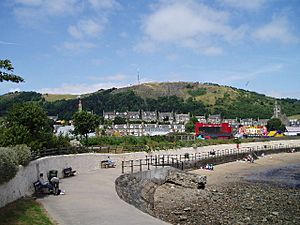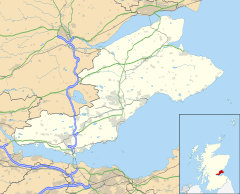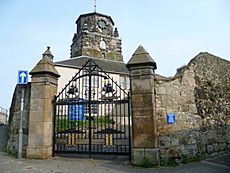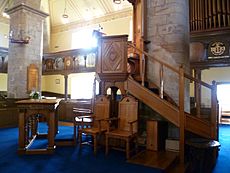Burntisland facts for kids
Quick facts for kids Burntisland
|
|
|---|---|
 A view across Burntisland |
|
| Population | 6,630 (2020) |
| OS grid reference | NT233859 |
| • Edinburgh | 7.5 mi (12.1 km) |
| • London | 339 mi (546 km) |
| Council area | |
| Lieutenancy area | |
| Country | Scotland |
| Sovereign state | United Kingdom |
| Post town | BURNTISLAND |
| Postcode district | KY3 |
| Dialling code | 01592 |
| Police | Fife |
| Fire | Fife |
| Ambulance | Scottish |
| EU Parliament | Scotland |
| UK Parliament |
|
| Scottish Parliament |
|
Burntisland is a town in Fife, Scotland. It is located on the northern shore of the Firth of Forth. In 2011, about 6,269 people lived there.
Burntisland is famous for its beautiful sandy beach, which has won awards. It also has Rossend Castle, a castle from the 15th century. Every summer, the town hosts a traditional fair and a Highland games day. North of the town, there's a hill called The Binn. It's a volcanic plug and stands about 193 meters (632 feet) tall, making it a clear landmark along the Fife coastline.
Contents
History of Burntisland
Early signs of people living in this area are rock carvings on The Binn. These carvings are thought to be around 4,000 years old! The Roman commander Agricola used the natural harbour here. He set up a camp at nearby Dunearn Hill in AD 83.
The first time Burntisland was mentioned in history was in the 12th century. At that time, monks from Dunfermline Abbey owned the harbour and nearby lands. The settlement was called Wester Kinghorn. It grew as a fishing village, providing food for the people living in Rossend Castle.
Later, King James V bought the harbour from the abbots of Dunfermline Abbey. In 1541, he made the land a royal burgh. This meant it had special rights from the king. In 1586, this status was confirmed. The town became independent from Kinghorn and was renamed Burntisland. Some people think the name came from fishermen's huts on an islet that burned down. This islet is now part of the docks. However, some historians believe the name might come from "Burnet's Land," after a local person.
The original church, built in the late 12th century, still has parts remaining in a churchyard north of the old town. A new church, Burntisland Parish Church (also known as St Columba's), was built in 1592. This was the first new church built in Scotland after the Reformation. It has a very unusual square shape with a central tower. Inside, it has galleries all around, so many people could hear the minister speak. The church has beautiful old wooden carvings and paintings from the 17th and early 18th centuries.
In 1601, King James VI chose Burntisland for a meeting of the Church of Scotland. It was here that they first talked about creating a new translation of the Bible. This project later became the famous King James Bible.
Burntisland grew into an important seaport, second only to Leith in the Firth of Forth. Shipbuilding became a major industry. King James V improved the harbour in 1540 and called it "Our Lady Port."
In 1622, a Spanish ship that was leaking entered the harbour and sank. The crew said they were whalers, but the town leaders were suspicious. They arrested the officers and put the rest of the crew under house arrest, thinking they might be pirates. They were later released. In 1633, a boat called the Blessing of Burntisland sank while carrying King Charles I's belongings and treasure from Burntisland to Leith.
During a conflict in 1715, the Jacobite army held Burntisland for over two months. They took control on October 9th and stayed until the government recaptured it on December 19th.
In 1844, a new pier was finished. This pier created a ferry link to a new harbour in Granton, Edinburgh.
Burntisland became important for the local herring fishing and coal industries. In 1847, the Edinburgh and Northern Railway opened, connecting Burntisland north to Lindores and Cupar. By 1850, the world's first roll-on/roll-off rail ferry service started. It crossed the Firth of Forth between Burntisland and Granton. This allowed goods wagons to travel between Edinburgh and Dundee without having to unload and reload. This service ran until 1890, when the Forth Bridge opened.
The Burntisland Shipbuilding Company was started in 1918 during the First World War. They built cargo ships. In 1929, they introduced the "Burntisland Economy" steamship, which saved a lot of fuel. This design helped the shipyard survive the Great Depression. During the Second World War, the yard continued to build merchant ships. It also built three Loch class frigates.
By 1961, the shipyard had 1,000 workers. But in 1968, the company faced money problems. The shipyard closed in 1969. Later, it was bought by another company, Robb Caledon. Robb Caledon eventually built parts for the North Sea oil and natural gas industry. However, this work declined, and the yard closed again in 1979. In 1990, under new owners, the Burntisland West Dock started making large parts for offshore oil and gas again. Today, the oil industry is still important for the town. In 2001, the yard became Burntisland Fabrications, or BiFab.
An alumina refining plant, opened by Alcan, closed in 2002. The land where it stood is now used for housing.
Highland Games
Burntisland is home to the second oldest highland games in the world! They started way back in 1652. The Games happen on the third Monday of July. A local market and summer fairground also take place on the same day.
Sport and Recreation
Burntisland Shipyard is the town's main football club. They play in the league.
The town also has one of the oldest golf clubs in the world, Burntisland Golf Club. It's known as the 'Old Club'.
The Beacon Leisure Centre has a 25-meter swimming pool with a wave machine and flumes. It also has gym facilities. It opened in 1997, replacing an old outdoor swimming pool.
One of Scotland's Great Trails, the 187 km Fife Coastal Path, goes through Burntisland. You can walk along the beach promenade and head towards Kinghorn. At low tide, you can even walk across the sands from the beach to Pettycur!
Education
Burntisland has one school, Burntisland Primary School. It's in a modern building that opened in August 2014. About 690 students attend, including nursery pupils. The old nursery building is still used too.
Most students go to secondary school at Balwearie High School in nearby Kirkcaldy. Catholic students go to St Marie's Primary School or St Andrews High School, also in Kirkcaldy.
Burntisland Viaduct
Just west of Burntisland railway station is the Burntisland Viaduct. It has nine arches and is a big part of the harbour area. It was built in 1888 to carry the main railway line from Edinburgh to Dundee. It is now a special Listed structure because it's a rare example of a surviving Town truss.
Attractions and Events
From May to August, an annual summer fairground comes to town. As mentioned, the second oldest highland games in the world are held here on the third Monday of July.
The Burntisland and District Pipe Band is a very successful band. They were British, UK, European, and World Champions in 2014! The band is known for helping children in the local area learn to play.
A free live music festival called Live on the Links also takes place every summer. It started in 1983 and now runs for a whole weekend in August at different places in town.
Transport
The A921 coast road runs through Burntisland. It connects to the M90 motorway in the west and the A92 in the east. The A909 road goes inland towards the A92.
Burntisland railway station is on the Fife Circle Line. You can take a train directly to Kirkcaldy in the north or Edinburgh in the south.
The town also has bus services provided by Stagecoach. Bus service 7 runs between Dunfermline and Leven. There's also a local B1 bus service that covers most areas of the town.
Town twinning
Burntisland is twinned with Flekkefjord, Norway. This partnership started in 1946.
Images for kids
See also
 In Spanish: Burntisland para niños
In Spanish: Burntisland para niños









